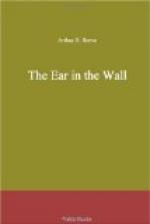There was no noise from the next room, but a tap on the door announced the waiter with luncheon. He shoved the settee back and joined us. The discreet waiter placed the food on the table and departed without a word or look. Kennedy resumed his work and we left the luncheon still untasted.
The bit seemed to have gone through as Kennedy, turning it carefully, withdrew it now and then to make sure. At last he seemed to be satisfied with the opening he had made.
From the package in his breast pocket he drew a long brass tube which looked as if it might be a putty-blower. Slowly he inserted it into the hole he had bored.
“What is it?” I asked, unable to restrain my curiosity longer.
“I felt sure that there would be no talking done in that room, especially as we are in this one and anyone knows that even if you can’t put a detectaphone in a room, it will often work if merely placed against a wall or door, on the other side, in the next room. So I thought I’d use this instead. Put your eye down here.”
I did so and was amazed to find that through a hole less than a quarter of an inch in diameter the brass tube enabled me to see the entire room next to us.
I looked up at Kennedy in surprise. “What do you think of this, Miss Kendall?” I asked, moving the settee out of her way. “What do you call it?”
“That is a detectascope,” he replied, “a little contrivance which makes use of the fish-eye lens.
“Yes. The detectascope enables you to see what is going on in another room. The focus may be altered in range so that the faces of those in the room may be recognized and the act of passing money or signing cheques, for instance, may be detected. The instrument is fashioned somewhat after the cytoscope of the doctors, with which the human interior may be seen.”
“Very remarkable,” exclaimed Clare. “But I can’t understand how it is possible to see so much through such a little tube. Why, I almost fancy I can see more in that room than I could with my own eyes if I were placed so that I could not move my head.”
Kennedy laughed.
“That’s the secret,” he went on. “For instance, take a drop of water. Professor Wood of Johns Hopkins has demonstrated recently the remarkable refracting power of a drop of water, using the camera and the drop of water as a lens. It is especially interesting to scientists because it illustrates the range of vision of some fishes. They have eyes that see over half a circle. Hence the lens gets its name—’the fish-eye lens.’ A globe refracts the light that reaches it from all directions, and if it is placed as the lens is in the detectascope so that one half of it catches the light, all this light will be refracted through it. Ordinary lenses, because of their flatness, have a range of only a few degrees, the widest in use, I believe, taking in only ninety-six degrees, or a little over a quarter of a circle. So you see my detectascope has a range almost twice as wide as that of any other lens.”




